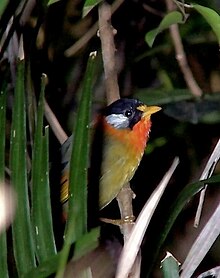Leiothrix (bird)
| Leiothrix | |
|---|---|

| |
| Silver-eared mesia Leiothrix argentauris | |
| Scientific classification | |
| Domain: | Eukaryota |
| Kingdom: | Animalia |
| Phylum: | Chordata |
| Class: | Aves |
| Order: | Passeriformes |
| Family: | Leiothrichidae |
| Genus: | Leiothrix Swainson, 1832 |
| Type species | |
| Parus furcatus[1] = Sylvia luteo Temminck, 1824
| |
| Species | |
Leiothrix is a genus of passerine birds in the family Leiothrichidae. They belong to a clade also containing at least the liocichlas, barwings, minlas and sibias. The sibias are possibly their closest living relatives.
Taxonomy[edit]
The genus Leiothrix was introduced in 1832 by the English naturalist William John Swainson with the red-billed leiothrix as the type species.[2][3] The genus name combines the Ancient Greek leios meaning "smooth" and thrix meaning "hair".[4]
The genus contains two species:[5]
| Common name | Scientific name and subspecies | Range | Size and ecology | IUCN status and estimated population |
|---|---|---|---|---|
| Silver-eared mesia | Leiothrix argentauris (Hodgson, 1837) Seven subspecies
|
South East Asia. | Size: Habitat: Diet: |
LC
|
| Red-billed leiothrix or "Pekin nightingale" | Leiothrix lutea (Scopoli, 1786) Five subspecies
|
India, Bhutan, Nepal, Burma and parts of Tibet. | Size: Habitat: Diet: |
LC
|
Their delicate colors and accomplished song make them popular cagebirds.
References[edit]
Wikimedia Commons has media related to Leiothrix (Aves).
Wikispecies has information related to Leiothrix (bird).
- ^ "Leiothrichidae". aviansystematics.org. The Trust for Avian Systematics. Retrieved 2023-07-15.
- ^ Swainson, William John; Richardson, J. (1831). Fauna Boreali-Americana, or, The Zoology of the Northern Parts of British America. Vol. 2: The Birds. London: J. Murray. pp. 233, 490. The title page bears the year 1831 but the volume was not published until 1832.
- ^ Mayr, Ernst; Paynter, Raymond A. Jr, eds. (1964). Check-List of Birds of the World. Vol. 10. Cambridge, Massachusetts: Museum of Comparative Zoology. p. 381.
- ^ Jobling, James A. (2010). The Helm Dictionary of Scientific Bird Names. London: Christopher Helm. p. 221. ISBN 978-1-4081-2501-4.
- ^ Gill, Frank; Donsker, David; Rasmussen, Pamela, eds. (January 2022). "Laughingthrushes and allies". IOC World Bird List Version 12.1. International Ornithologists' Union. Retrieved 6 June 2022.
- Cibois, Alice (2003): Mitochondrial DNA Phylogeny of Babblers (Timaliidae). Auk 120(1): 1-20. DOI: 10.1642/0004-8038(2003)120[0035:MDPOBT]2.0.CO;2 HTML fulltext without images
- Collar, N. J. & Robson C. 2007. Family Timaliidae (Babblers) pp. 70 – 291 in; del Hoyo, J., Elliott, A. & Christie, D.A. eds. Handbook of the Birds of the World, Vol. 12. Picathartes to Tits and Chickadees. Lynx Edicions, Barcelona.


